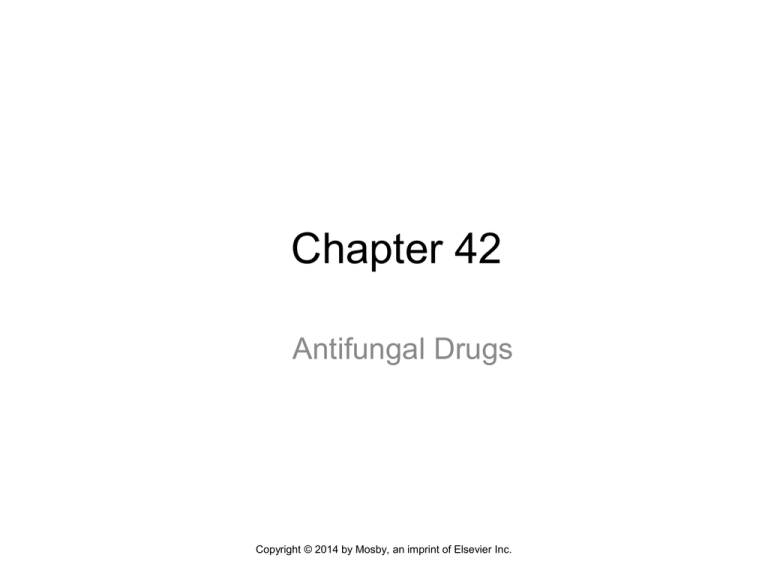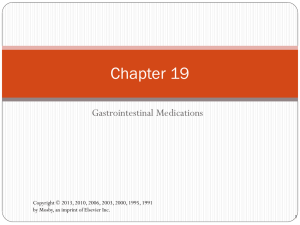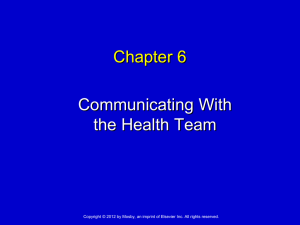Pharmacology and the Nursing Process, 4th ed. Lilley/Harrington
advertisement

Chapter 42 Antifungal Drugs Copyright © 2014 by Mosby, an imprint of Elsevier Inc. Fungi Very large and diverse group of microorganisms, including yeasts and molds Fungal infections also known as mycoses Some fungi are part of the normal flora of the skin, mouth, intestines, and vagina Copyright © 2014 by Mosby, an imprint of Elsevier Inc. 2 Yeasts Single-cell fungi Reproduce by budding Can be used for Baking Alcoholic beverages Copyright © 2014 by Mosby, an imprint of Elsevier Inc. 3 Molds Multicellular Characterized by long, branching filaments called hyphae Copyright © 2014 by Mosby, an imprint of Elsevier Inc. 4 Mycotic Infections Four general types Cutaneous Subcutaneous Superficial Systemic • Can be life threatening • Usually occur in immunocompromised host Copyright © 2014 by Mosby, an imprint of Elsevier Inc. 5 Mycotic Infections (cont’d) Candida albicans May follow antibiotic therapy, antineoplastics, or immunosuppressants (corticosteroids) May result in overgrowth and systemic infections Growth in the mouth is called thrush or oral candidiasis Common in newborn infants and immunocompromised patients Copyright © 2014 by Mosby, an imprint of Elsevier Inc. 6 Mycotic Infections (cont’d) Vaginal candidiasis Yeast infection Pregnancy, women with diabetes mellitus, women taking oral contraceptives Copyright © 2014 by Mosby, an imprint of Elsevier Inc. 7 Classroom Response Question A patient has developed an aspergillosis infection. Which tissue does the aspergillosis affect? A. B. C. D. Skin Nails Blood Lungs Copyright © 2014 by Mosby, an imprint of Elsevier Inc. 8 Antifungal Drugs Drugs used to treat infections caused by fungi Systemic amphotericin B, caspofungin, fluconazole, voriconazole, terbinafine Topical nystatin, terbinafine Copyright © 2014 by Mosby, an imprint of Elsevier Inc. 9 Antifungal Drugs (cont’d) Broken down into major groups based on their chemical structure: Polyenes: amphotericin B and nystatin Imidazoles: ketoconazole Triazoles: fluconazole, itraconazole, voriconazole Echinocandins: caspofungin, micafungin Drugs that are listed individually, not by chemical structure: • griseofulvin, flucytosine Copyright © 2014 by Mosby, an imprint of Elsevier Inc. 10 Mechanism of Action flucytosine Also known as 5-fluorocytosine (antimetabolite) Taken up by fungal cells and interferes with DNA synthesis Result: fungal cell death Older drug; newer drugs are more commonly used Copyright © 2014 by Mosby, an imprint of Elsevier Inc. 11 Mechanism of Action (cont’d) griseofulvin Disrupts cell division Result: inhibited fungal mitosis (cell division) Older drug; newer drugs are more commonly used Copyright © 2014 by Mosby, an imprint of Elsevier Inc. 12 Mechanism of Action (cont’d) Polyenes: amphotericin B and nystatin Bind to sterols in cell membrane lining Result: fungal cell death Do not bind to human cell membranes or kill human cells Copyright © 2014 by Mosby, an imprint of Elsevier Inc. 13 Mechanism of Action (cont’d) Imidazoles and triazoles: ketoconazole, fluconazole, itraconazole, voriconazole Inhibit fungal cell cytochrome P-450 enzymes, resulting in cell membrane leaking Result: altered cellular metabolism and fungal cell death Copyright © 2014 by Mosby, an imprint of Elsevier Inc. 14 Mechanism of Action (cont’d) Echinocandins: capsofungin, micafungin, and anidulafungin Prevent the synthesis of glucans (essential components of fungal cell walls) Result: fungal cell death Copyright © 2014 by Mosby, an imprint of Elsevier Inc. 15 Indications Systemic and topical fungal infections Drug of choice for the treatment of many severe systemic fungal infections is amphotericin B Choice of drug depends on type and location of infection Copyright © 2014 by Mosby, an imprint of Elsevier Inc. 16 Classroom Response Question A patient is diagnosed with onychomycosis. The nurse anticipates use of which medication for the treatment of this condition? A. terbinafine (Lamisil) B. voriconazole (Vfend) C. fluconazole (Diflucan) D. amphotericin B (Amphocin, Fungizone) Copyright © 2014 by Mosby, an imprint of Elsevier Inc. 17 Adverse Effects: Amphotericin B Cardiac dysrhythmias Neurotoxicity; tinnitus; visual disturbances; hand or feet numbness, tingling, or pain; convulsions Renal toxicity, potassium loss, hypomagnesemia Pulmonary infiltrates Fever, chills, headache, nausea, occasional hypotension, gastrointestinal upset, anemia Copyright © 2014 by Mosby, an imprint of Elsevier Inc. 18 Classroom Response Question A patient is receiving amphotericin B lipid complex. The nurse knows that an advantage of the lipid formulations of this drug is that they A. have a lower cost. B. can be administered quickly. C. take longer to be absorbed. D. cause fewer adverse effects. Copyright © 2014 by Mosby, an imprint of Elsevier Inc. 19 Antifungal Drugs: Adverse Effects fluconazole Nausea, vomiting, diarrhea, stomach pain, Increased liver enzymes Use with caution in patients with renal and liver dysfunction nystatin Nausea, vomiting, anorexia, diarrhea, rash Copyright © 2014 by Mosby, an imprint of Elsevier Inc. 20 Antifungal Drugs: Contraindications Liver failure Renal failure Porphyria (griseofulvin) Drug allergy Copyright © 2014 by Mosby, an imprint of Elsevier Inc. 21 Antifungal Drugs: Interactions Many antifungal drugs are metabolized by the cytochrome P-450 enzyme system Coadministration of two drugs that are metabolized by this system may result in competition for these enzymes, and thus higher levels of one of the drugs Copyright © 2014 by Mosby, an imprint of Elsevier Inc. 22 Nursing Implications Before beginning therapy, assess for hypersensitivity, possible contraindications, and conditions that require cautious use Obtain baseline VS, CBC, liver and renal function studies, and ECG Assess for other medications used (prescribed and over-the-counter) to avoid drug interactions Copyright © 2014 by Mosby, an imprint of Elsevier Inc. 23 Nursing Implications (cont’d) Follow manufacturer’s directions carefully for reconstitution and administration Monitor vital signs of patients receiving IV infusions every 15 to 30 minutes During IV infusions, monitor I&O to identify adverse effects Copyright © 2014 by Mosby, an imprint of Elsevier Inc. 24 Classroom Response Question Fifteen minutes after an infusion of amphotericin B was started, the patient begins to complain of fever, chills, muscle pain, and nausea. His heart rate has increased slightly, but his blood pressure is down to 100/68. What is the nurse’s priority? A. Notify the prescriber immediately. B. Recognize an impending anaphylactic reaction and stop the infusion. C. Assess for other symptoms of this expected infusionrelated reaction. D. Slow the infusion to reduce these adverse effects. Copyright © 2014 by Mosby, an imprint of Elsevier Inc. 25 Nursing Implications (cont’d) amphotericin B To reduce the severity of the infusion-related reactions, pretreatment with an antipyretic (acetaminophen), antihistamines, antiemetics, and corticosteroids may be given Use IV infusion pumps and the most distal veins possible Copyright © 2014 by Mosby, an imprint of Elsevier Inc. 26 Nursing Implications (cont’d) Some oral forms should be given with meals to decrease GI upset; others require an empty stomach—be sure to check Copyright © 2014 by Mosby, an imprint of Elsevier Inc. 27 Classroom Response Question A patient is taking nystatin (Mycostatin) in an oral troche form for oral candidiasis. Which instruction is correct? A. B. C. D. Allow the troche to dissolve slowly in the mouth. Swish the medication in the mouth and then swallow it. Chew the troche thoroughly to activate the medication. Swallow the troche whole without chewing. Copyright © 2014 by Mosby, an imprint of Elsevier Inc. 28 Nursing Implications (cont’d) Nystatin given as an oral lozenge or troche should be slowly and completely dissolved in the mouth (not chewed or swallowed whole) Nystatin suspension should be swished thoroughly in the mouth as long as possible before swallowing Copyright © 2014 by Mosby, an imprint of Elsevier Inc. 29 Nursing Implications (cont’d) Monitor for therapeutic effects Easing of symptoms of infection Improved energy levels Normal vital signs, including temperature Monitor carefully for adverse effects Copyright © 2014 by Mosby, an imprint of Elsevier Inc. 30




